Medieval (about 476AD-1600’s)
16
Sydney Fitch; Levi Williams; Joe Lady; Alexandria Alabau; Madison Bolick; CaitlinHall; and Leta Kate Lamb
Introduction
The Medieval Era is often overlooked when it comes to their accomplishments in the progression of science and technology. Although the period is associated with depictions of medieval knights rushing to battle and the infamous Bubonic Plague sweeping over Europe, the science and technology conceived from these matters were substantial milestones in the advancement of science and technology in society. During the Medieval Era, from the year 476 to 1600 AD, society saw an advancement in science and technology that greatly impacted the areas of health, agriculture, and economics. By the end of this chapter you will learn how these advancements were also influenced by the political and religious circumstances evolving throughout this time period.
Technology and the church
The Medieval time period is often referred to as the “Dark Ages” partly because of the notion that it lacked scientific or technological advancement. This is largely due to the rise of the Christian Church that took control of almost all aspects of life including religious, government and scientific functions of the Roman Empire (McCall, 2018). Religion from a scientific standpoint was only to get closer to God and unveil His creations (McCall, 2018). The Catholic Church during the Middle Ages hindered scientific advancement because it feared that scientific reasoning would threaten its authority; however the introduction of new technologies was not seen as such of a threat and was integrated into people’s lives such as the invention of the chimney. Scientific reasoning for natural phenomenon could have called into question the Church’s place of power. This is why certain scientific practices were strictly controlled by the church, like that of human dissections for learning the anatomy of the body.
It was not until the year 313 that Christianity was legally recognized as a religion (Nelson, 2001). This was because of the efforts of Constantine who turned the religion into a structured institution of its own that unified the East and the West after the fall of the Roman Empire (Nelson, 2001b). To Constantine, keeping the authority of the church meant preserving its appearance and capabilities. The Church became more than just a religion, it became the center of community life (Park, 1994). For centuries, scientific learning was confined to monasteries and cathedral schools where monks and priests would learn and teach sciences such as medicine, architecture, astronomy, and arithmetic (Park, 1994). The sick were able to be healed in the name of God, new churches were able to be built, prayer times and religious holidays were establish-
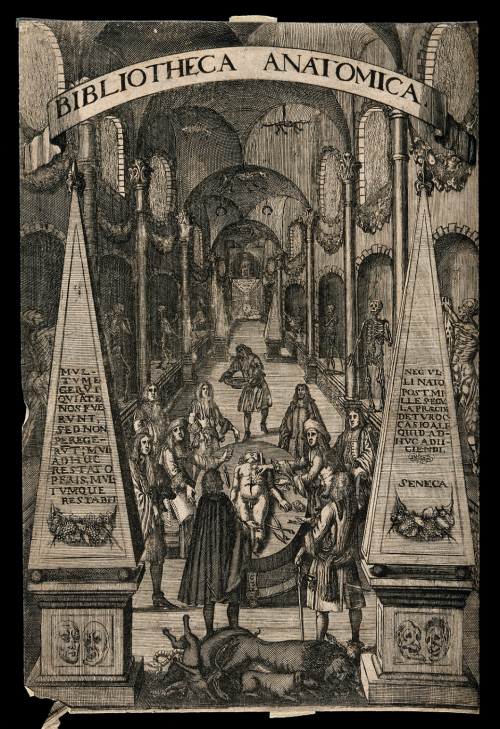
ed, and the financial accounts of the Church were able to be well kept (Nelson, 2017). However, the subjects were bound to the rules established by the Church, and consequently, scientific advancement was impeded.
Under these conditions, there was little to no room for scientific growth outside of the church. For example, public dissections of human bodies were given solely by the church and considered moral religious events . They were seldom given for the reason that it was said that after death the body should remain whole for resurrection . This tactic limited the science of anatomy and sequentially prevented progress in the medical field. If the people of the community were able to restore their health by science instead of the power of prayer from the Church, they would lose faith in the Church’s abilities and not be obliged to make donations to the Church for their services.
Alternatively, technology outside the Church did not pose a threat. The community’s technological focus was on the improvement of work and home life (White, 1978). The Church was fond of such achievements because more work done in the community meant a larger tithe would be given to the church (Park, 1994). The chimney was a revolutionary achievement because its warmth allowed work to be done through the winter months (Dresbeck, 1971). Additionally, the chimney benefited home life by making it easier to cook and carry out separate activities in the house (Dresbeck, 1971). People were not confined to a centralized hearth. Singular rooms such as kitchens and bedrooms took the place of large one-roomed homes.
Many technological advancements occurred throughout the Medieval time period that impacted agriculture, textiles, and building construction. None of which negatively impacted the Christian Church or its authoritative image. The Church was able to maintain control over scientific knowledge, yet allow the development of new technology that would ultimately carry society out of the “Dark Ages.”
politics and society: The FEUDAL system
Along with the powers of the Church during the Medieval era, political power was a combination of legal, economic, and military customs. Feudalism, in which rulers granted land to lower nobility in return for military service, was the prominent political system in central Europe. These nobles, in turn, made similar exchanges with vassals, who were subordinates that held small plots of land. The working class then provided labor for these vassals, nobles, and rulers in exchange for military protection. Before the rise of feudalism, political systems relied mostly on a strong centralized government. Rather than power resting with kings and emperors, much of the power was held by local elites or lords. The beginning stages of feudalism can be traced back to Charles Martel, who lived from 686 to 741. Charles Martel’s adoption of mounted cavalry, along with the invention of the stirrup, contributed greatly to the rise of feudalism in medieval Europe.
Charles Martel was the Mayor of the Palace of Austrasia from 715 to 741 (Duckett, 2019). Austrasia was the eastern area of the Frankish kingdom – a kingdom that covered modern-day Germany and France. Martel consolidated power by conducting a civil war and securing Frankish lands. In 721, Muslim Umayyads invaded the Frankish kingdom from Spain. Heinrich Brunner, a German historian, claimed it was the Muslim invasion that generated feudalism in medieval Europe (White ,1964). The invasion led Martel to seek the development of a professional army rather than one made mostly of conscripts to counter the Muslim horsemen. To pay his professional warriors, he confiscated church lands and distributed them to his followers.
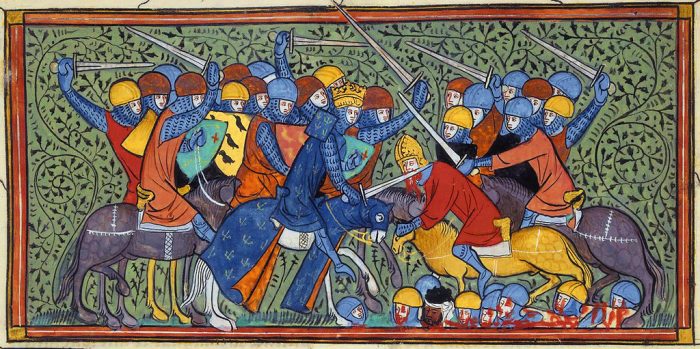
According to Lynn Townsend White, author of Medieval Technology and Social Change, “Martel’s diversion of a considerable part of the Church’s vast riches to military purposes therefore was contemporary with the shift of the focus of the Frankish army from infantry to cavalry” (White, 1964). In exchange for Martel giving his followers land, they were required to serve in his military as mounted cavalry. The trade of land for allegiance is an example of vassalage, a core component of a feudal society. The use of cavalry became even more of an advantage with the invention of the stirrup. According to White, the stirrup made mounted shock combat possible by allowing warriors to replace their own energy with the power of the horse (White, 1964).
After the invention of the stirrup, knights emerged in Europe as a warrior class that doubled as both rulers and fighters. When knights died, their sons inherited their land and position in society (Comshaw-Arnold, 2014). This led to much of Europe becoming ruled by decentralized feudal lords. These lords made agreements and designed contracts to establish power. Lords that became more powerful absorbed the lesser lords and their territories leading to the lesser lords becoming vassals (Nelson, 2017).
Feudalism spread throughout Europe and was the dominant social and political structure used up until the end of the fourteenth century. Charles Martel’s decision to give land to professional fighters in exchange for their military service is the origin of this political system. These landowners became local lords and knights that made up the class of nobility. The invention of the stirrup increased the value of the nobility as mounted cavalry became essential to winning battles.
the marriage of church and state
The Middle Ages were filled with powerful and noble kings. When Charles Martel ruled the Franks, he was considered one of the most noble kings to reign. Many wondered what would become of the Frankish kingdom when he was gone. Little did they know the most majestic king of the Franks was yet to come. Charlemagne, the son of Charles Martel was one of the most renowned kings ever. In his time, religion was tightly interwoven with society, especially with political power. Charlemagne used the divine right of kings to reunite Europe through military power, technological advancements such as medicine, currency and the central church.
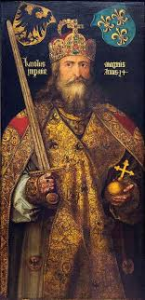
Charlemagne has always been considered one of the greatest military leaders of all time. Much of his strength came from his loyal army who dared not question his commands. His greatest enemies were the Saxons. His war on Saxony lasted from 772 to 804 B.C. (Sullivan, 2020). The Franks’ advantage came in the military genius of Charlemagne. He utilized elaborate combat strategy that overwhelmed the Saxons over time. The Saxons were simply fighting for survival. Their survival could not last against the Frankish army (Mayr-Harting, 1996). Charlemagne’s legacy grew over his years of war. He won countless battles, but none more famous than the battle of Roncevaux, in which the famous Song of Roland was born from. In this poem, Charlemagne prayed that the sun would stand still so that he could fight on and win the day: “As he prayed, it was done, and he fought to victory” (O’Hagen, 1910). Tales like these set Charlemagne apart as the greatest hero during his reign.
Charlemagne built his fame as he made way for technological advancements to be produced throughout his kingdom. He saw that technology was a great unifier across all cultures, as it allowed people to work together more efficiently. One of the biggest industries being advanced in the Frankish kingdom during Charlemagne’s reign was medicine. Charlemagne was believed to be one of the first kings who investigated legal medicine by holding physicians accountable for dangerous or even deadly medicines they sold to their patients (Brittain, 1966). Charlemagne implemented a Frankish currency by looking to the past for advice. In earlier times, the Romans united their conquered lands by creating a consistent currency, and Charlemagne realized this would contribute greatly to unifying his land (Sullivan, 2020). From this implementation of a central currency, the Franks prospered.
In addition to unifying his kingdom, Charlemagne also centralized the Church. After Constantine’s rule declared Christianity as the official religion of the Roman Empire, those involved in the Church began to gain power (Little, 2020). Charlemagne understood this dynamic and used it to his own advantage. He strongly believed that God chose to give him unlimited power over his kingdom – the divine right of kings. His power only grew when he was proclaimed the first Holy Roman Emperor by the Pope on December 25, 800 in Rome (Grabois, 1981). Charlemagne executed this authority ruthlessly, but justly. He did not tolerate contempt or defiance, but he showed gratitude and kindness to his loyal citizens.
Central Europe advanced in numerous ways during Charlemagne’s reign, and he is still considered as the great king who united Europe (Whitney, 2004). Charlemagne built himself a renowned legacy for his strength and justice to his people. He applied the divine right of kings to reunite Europe through military power, technological advancements, and centralizing the power of the Roman Catholic Church. His technological advancements of medicine and agriculture helped to unify the kingdom and provide opportunity for prosperity.
technological and health advances
The Medieval era spanned throughout the year 476 to the 1600’s, changing the way the European society functioned and developed, especially agriculturally. In much of European history, farming dominated the economy. During earlier years, much of the farming community relied on field workers or animals, particularly oxen, to plow farmland. During the Medieval era, the migration of many people into central Europe caused a large population influx, leading to a higher demand for food and commercial goods to be produced. This inflation caused a major change in agricultural techniques that allowed for a more efficient cultivation of land. The harnessing of non-traditional animals, especially horses, provided a much more powerful and efficient standard to farming during the Medieval period.
In the Medieval era, the harnessing of animals for farming uses was relatively uncommon, with only the oxen being a popular plow animal. The use of oxen as draft animals allowed for more efficient plowing than by hand, since oxen were known as being sturdy and reliable farm animals. However, during the major migration period and the inflation of central European society between the years 1050 and 1200, there was a higher demand than ever for food to sustain the population (Noble, 2016). Although oxen were reliable and powerful draft animals, horses were known to have much higher stamina and overall strength. Because of this, people began using horses as draft animals who proved to be more efficient tools in farming (Noble, 2016). By employing the horse as a draft animal, farms and fields were able to be more easily managed and more food was able to be harvested.
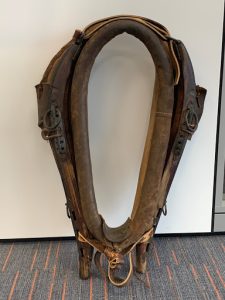
Despite the beneficial outcomes of harnessing horses as draft animals, horses are clearly much different than oxen. Because of their different stature, new harnessing equipment was required to be made in order to properly begin the usage of horses as field animals. This began the technological change in agriculture and farming. To effectively harness a horse for farm work, a new collar had to be made to fit the horse’s neck and attach the heavy plow. Attachment of the heavy plow to the horse collar allowed for easier and more efficient farming of a wide expanse of farmland, especially in harsh environments covered in solid earth (Astill, 1997). Additionally, horses have much softer hooves than oxen and therefore required shoes to help them with their stamina and endurance when working rough land.
The development of many different types of agricultural technologies allowed for easier production, harnessing, and cultivation of the land (Wigelsworth, 2006). The harnessing of draft animals, especially horses, during the Medieval era allowed for a much more efficient farming technique. Horses could more easily plow larger and harsher lands than the previously employed oxen (Noble, 2016). This allowed for land that had been thought to be too rough to be used as farmland, which could then be harvested to feed the growing society in central Europe. Additionally, the use of horses as working farm animals allowed farmers to begin to employ other animals like sheep and cattle to graze, which helped grow the European economy based on the demand for animal products (Hubbard, 2011). This allowed Medieval Europe to both grow within their own agricultural community as well as making them large financial players in the world economy.
In Medieval Europe, trade and migration brought mass amounts of people into the central European population. From this growing population, the European community faced a challenge of how to feed everyone since food was in high demand. Through the use of draft animals, specifically horses, harnessing the harsh European landscape became easier for farmers to utilize, which allowed for a wider expanse of land that could be used for farmland. The control of this land permitted the central European community to sustain their growth while being able to then focus on other lifestyle aspects without the worry of an under availability of food.
Along with agricultural progressions, another key advancement during the Medieval era was the medicinal field. During this time period, physicians began to more freely experiment with different practices and medicines. For example, described as the study of eye disease and disorders, ophthalmology is a key branch of the medical field with serious implications on the success of society. In the latter part of the Medieval Period, Islamic researchers began studying ophthalmology more closely, likely with the goal of improving their medical practice, as well as solving the prevalent problem of blindness due to cataracts and trachoma. This research led to scientific discoveries that permanently revolutionized the study and treatment of eye disease. Advances in ophthalmology during the Medieval Period had an instrumental impact on society as novel surgical equipment and procedures for the resolution of cataracts and trachoma were developed, the ability to remove cataracts and heal trachoma literally opened the eyes of a significant portion of the population, and new knowledge of eye anatomy and physiology would have a significant impact on future research of eye disease.
Known during the Medieval Period as the most significant cause of disability in Islamic areas of the world, blindness was a population-wide affliction that begged a resolution (U.S. National Library of Medicine, 2011). Before ophthalmological research in this period, people primarily utilized eye disease remedies suggested in 5th century B.C.E. by Hippocrates, such as restricting their diets, taking hot footbaths, and making incisions in the scalp to release the “morbid humors” of the eye (Dahn, 2018). The first significant ophthalmological research in response to this affliction began in the 800’s with a physician known as Hunayn ibn Ishaq. He authored several works detailing what was known at the time about eye disease, from which a hand-drawn image of the eye is displayed below (U. S. National Library of Medicine, 2011). This initial image demonstrates a knowledge of certain aspects of the eye, but does not include everything needed to cure blindness. Fast forward to the 13th century, research and publications on eye disease by various scientists over the years ultimately led to the surgical approach of “couching” applied to the removal of cataracts. Couching involves utilizing a probe, or needle, to poke through the edge of the cornea and move the affected lens out of the path of vision, leaving it to rest at the bottom of the eyeball.
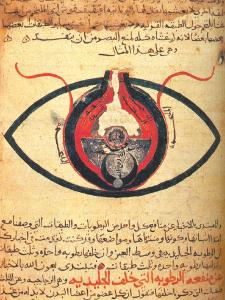
With a success rate of 40% and many failures due to infection and glaucoma, this method of cataract removal became widely accepted, as it was the first and only solution available at the time (U.S. National Library of Medicine, 2011). In addition to cataract removal, procedures were formulated for treatment of other common diseases, such as: utilizing a scraper to clear an eye infection known as trachoma (a major cause of blindness), creating a contraption of hooks used to keep the eye open when treating a vascularization of the eye known as trachomatous pannus, and developing intricate, and painful, surgical methods for resolving rolled in eyelids and ingrown eyelashes (U.S. National Library of Medicine, 2011). These advances, although they may have taken some time to perfect, represented key initial steps in the development of cures for blindness. This allowed individuals previously affected with this disorder to continue working at their jobs, thus lengthening their period of opportunity to contribute to society.
The newfound ability of surgeons to treat cataracts and trachoma, two of the most common causes of blindness in the Medieval Period, was a revolutionary step for society. Individuals that had previously been limited by an inability to see were suddenly granted the ability to transition back to their lives before the disorder. According to Savage-Smith, the medieval world “afforded few means of livelihood for a blind person”(2000). For example, if an architect had suffered from a progressive or sudden onset of blindness, it would have been nearly impossible to continue working in this field without the ability to draw or visualize the construction of a building. With blindness cured in a considerable amount of the population due to surgical advances, it can be assumed that these individuals, along with individuals of numerous other professions, were able to return to their jobs and continue making advances in technology, science, art, and innovation. Not only did curing blindness allow a greater proportion of the population to contribute to society, but it also laid the foundation for improved societal health and future advances in medicine.
With improved surgical procedures in ophthalmology came an expanded knowledge of the anatomy and physiology of the eye. As previously mentioned, Hunayn ibn Ishaq played a key role in the foundation of ophthalmology, and his work on Ten Treatises of the Eye placed all that was known about the human eye during his time into one document (Lin, 2008). Following Hunayn, the tenth century brought a new work, titled Memorandum Book for Oculists, written by Ali ibn Isa, which became the standard, widely-recognized source of information for ophthalmologists for several centuries to follow. These Arabic works, along with several more, were later passed on to European nations, essentially laying the foundation of ophthalmology not only for Arabic societies, but for the rest of the world (Lin, 2008). The dedicated research carried out by Islamic ophthalmologists in the Medieval Period involved hard work, attention to detail, and “clinical trials” of sorts, which resulted in a new medical body of knowledge that was shared with the world, ultimately improving all of humanity’s medicine, health, productivity, and contributions to society.
Advances in ophthalmology during the Medieval Period had an instrumental impact on society as novel surgical equipment and procedures for the resolution of cataracts and trachoma were developed, the ability to remove cataracts and heal trachoma opened the eyes of a significant portion of the population, and new knowledge of eye anatomy and physiology would have a significant impact on future research of eye disease. These advances not only improved the general health of the population, but also permitted many individuals suffering from blindness to be healed and return to their previous role in society. Overall, the world’s body of medical knowledge grew, societal health improved, and the result was more opportunity for individuals to contribute to and improve upon science, technology, and society.
Along with evolving medicinal practices, overall general health was a significant part of medieval community standards. Medicines and hygienic techniques were able to be practiced more freely during this time period, allowing for experimentation and new ideas to flourish. Although not all of the hygiene practices worked, those that did resulted in beneficial outcomes. Certain substances cured wounds and served as the first forms of antibiotics. One example that worked as a type of antibiotic was penicillin, found in certain types of moss. Although society did not know the exact reason why the antibiotic worked, they recognized its beneficial properties and appreciated the cure. Through its use, the penicillin antibiotic worked to save many lives during the Middle Ages. Another substance that held medicinal factors was honey, used throughout the Medieval era for its beneficial health properties. Although not known at the time, honey has natural antibacterial properties to it, and when applied to an open wound, could save a life.
Along with these simple forms of antibiotics, another huge success in the world of hygiene during the Medieval period was dentistry. Archeologists have found that those living in this time period have on average 20% tooth decay in comparison to 90% of
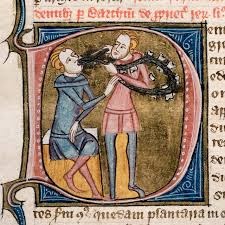
those who came before the medieval period (O’Neill, 2017). As a societal norm, having fresh breath and attractive teeth was imperative. As a result, rough linens and mixtures with cow bones were used to keep teeth clean. If a tooth began to rot or deteriorate, it was simply removed to decrease further decay.
Although several forms and practices of hygiene provided great benefits to Medieval society, not every experiment worked. Because of the society-wide desire for cleanliness and good presentation, drastic measures were taken to attempt any beauty improvements. With this in mind, the Middle Ages experimented with new creations of makeup and other unique beauty trends. Although coined as the “Dark Ages”, both women and men wanted to look their best. An example of beauty attempts can be found in The Trotula: A Medieval Compendium of Women’s Medicine (Green, 2013). One of the biggest makeup “failures” of the Middle Ages was the use of lead and other harmful substances. The recipes found in this book called for many local and healthy ingredients, like herbs and animal products, as well as imported substances like frankincense, cloves, cinnamon, nutmeg, galangal. However, many of the recipes required several harmful mineral substances including arsenic, quicksilver, sulfur, natron, and lead. These harmful minerals can ultimately cause damage to an individual and destroy the skin from the outside- in. For example, it is popularly believed that these beauty minerals were the cause of Queen Elizabeth I’s madness and untimely death.
Although not every hygienic or medicinal practice worked out, it is important to recognize those that did. From the small, simple antibiotic practices to the large-scale dentistry and makeup used during the Medieval era, society saw progression and benefits in overall health and wellness. The early forms of the antibiotics were simple but effective in preventing wounds from infection and sicknesses from severe. Dentistry helped to keep individuals in good health and in good presentation. The makeup used at the time may have been dangerous, but it provides a significant insight into the societal norms and the culture at that time.
Although the physical objects and practices of the Medieval period often gain much acknowledgement, a key aspect of the era was time. Despite not being a concrete object or practice, time was an important factor of Medieval society. During the early Middle Ages, time was inaccessible and the only hint was signaled by a church bell ringing or the casting of shadows. This all changed with the invention of the mechanical clock. Previous time telling inventions, church clocks, and the mechanical clocks all affected society by contributing to stricter schedules for workers and changing the societal view of time in the Medieval Era.
A few time telling devices came before the development of the mechanical clock. The first of which were sundials. Sundials are the oldest known devices used to measure time, measuring time-based on the distance and rotation of the sun. These devices are also known and celestial timepieces. The next time telling device was the hourglass, which were mostly used in ship navigation and to regulate clergy meetings. Although navigation of a ship seems impossible by an hourglass, it is said that the “sand clocks had some relative value in approximating longitudinal position” (Balmer, p. 620) and were helpful in regulating seamen’s watches. The final invention leading up to the creation of the mechanical clock was the water clock. The water clock was made up of a vertical tank that water flowed into. The rising water level indicated what time of day it was. Water clocks, like mechanical clocks, also had dials and gears, but they were less accurate than mechanical clocks.
Before the invention of the mechanical clock, church clocks in the Medieval era were the most accessible form of telling time for much of society since churches were often built in the center of a city or town. Before the clock, church bells rang out, but not all hours of the day, and they were impossible to hear on a voyage at sea. Additionally, they were not completely accurate. This is shown by Enstam (2017) when she says “Whatever their social roles, the bells of the town clocks tolled the half- and quarter-hours as closely as their builders could manage, usually within fifteen minutes either way.” The church bells helped to regulate the daily life of workers, as they could tell whether it was the first or the fifth hour by counting the clock bells throughout the day, but often provided little accuracy. This all changed once the mechanical clock was developed.
Weight-driven devices, like the water wheel, and other time indicators existed in earlier societies, but a mechanism called escapement only appeared in the last third of the 13th century. This mechanism was the key technological novelty that allowed for the construction of the first mechanical clock (Alvarez, 2017). Escapement is “the balance wheel on a watch or the pendulum on a grandfather clock”(Lienhard, n.d). This ticks in a steady motion and allows gears to move forward in a series of little jumps. The mechanical clock was able to provide Medieval society with more accurate time-telling resources. By doing so, society was able to function and progress more efficiently and productively.
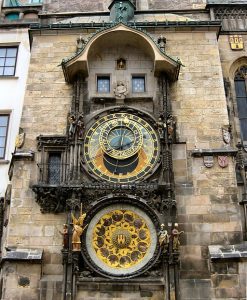
After the mechanical clock was invented in the 14th century, the societal view of time was changed. The newfound accessibility of time made it easier to synchronise schedules. With the invention of the mechanical clock, society was able to perform tasks on schedules and people were able to make plans at a concrete time. Additionally, workers schedules became more defined. Enstam (2017) states that before the mechanical clock, “The masons’ workday was loosely defined, beginning as soon in the morning as they could see to “work skill- fully” and stopping with the coming of evening.” Now, the mechanical clock prompted when it was time to wake up, end a workday, eat meals, and go to sleep.
The mechanical clock was also able to tell time more accurately than any of the previous time telling inventions. This made estimating longitude on ships a lot more reliable (Bradbury & Collette, 2009). Since discovering that time could be broken into smaller pieces, like minutes and seconds, society began to wonder what other aspects of time could be broken down. This sparked a lot of curiosity and was one of the main motivators behind the Age of Travel and Trade.
By having access to accurate measurements of time, Medieval society was revolutionized by the mechanical clock. The inventions leading up to the mechanical clock and the change in societal view of time led to progression towards more accurate technology. The mechanical clock provided Medieval societies with the opportunity to create schedules and work around more accurate telling of time. Without the invention of the mechanical clock, society might have not been able to advance as quickly as it did.
Conclusion
The religious and political systems of the medieval world allowed for periods of stability in many regions where advancements in science and technology could be made. People developed new ways to handle agriculture, medicine, and hygiene. Being able to warm homes during the winter months with chimneys and tracking time with a mechanical clock were also products of technological advancements made throughout the medieval era. Science and technology during this period had a great influence on society then and its influence is still relevant today.
Chapter Review Questions
- True or False In the Middle Ages, there was a division between science and religion.
- True or False The Black Plague led to the death of ⅓ of the European population and in turn caused a complete loss of prior advances in farming technologies.
- True or False In the Medieval Period, many advances in the field of ophthalmology were made by German physicians.
- True or False Medieval culture was heavily influenced by a desire for cleanliness and hygiene regardless of its reputation.
- Short Answer: Before mechanical clocks, a typical worker’s day was loosely defined by before or afternoon. How did the development of mechanical clocks affect a worker’s schedule and the general society as a whole?
- Short Answer: In the Medieval Era, trade was an important factor that led to the growth of society. With a booming population, Medieval Europe advanced in many technological areas and needed to feed a much larger community. What were some ways in which the farming culture of Medieval Europe changed during this time period?
References
Alvarez , V. P. (2017). The role of the mechanical clock in medieval science. Endeavour, 39(1).
Astill, G. G., & Langdon, J. (Eds.). (1997). Medieval farming and technology: The impact of agricultural change in Northwest Europe (Vol. 1). Brill.
Balmer, R. T. (1978). The Operation of Sand Clocks and Their Medieval Development. Technology and Culture, 19(4), 615–632. doi: 10.2307/3103761
Bradbury, N., & Collette, C. (2009). Changing Times: The Mechanical Clock In Late Medieval Literature. The Chaucer Review, 43(4), 351-375. https://www.jstor.org/stable/25642120
Brittain, R. P. (1966). The history of legal medicine: Charlemagne. Medico-Legal Journal, 34(3), 122-123.
Comshaw-Arnold, B. (2014). Feudalism in Decline: The Influence of Technology on Society. (Electronic Thesis or Dissertation). https://etd.ohiolink.edu/
Dahn, T. (2018). Seeing is Believing: Ophthalmology Over the Ages. Historical Medical Library of the College of Physicians of Philadelphia. Retrieved from https://histmed.collegeofphysicians.org/seeing-is-believing-ophthalmology-over-the-ages/
Dresbeck, L. (1971). The Chimney and Social Change in Medieval England. Albion: A Quarterly Journal Concerned with British Studies, 3(1), 21-32. doi:10.2307/4048469
Duckett, E. S. (2019, October 18). Charles Martel. Encyclopedia Britannica. Retrieved from https://www.britannica.com/biography/Charles-Martel
Enstam, E. Y. (2017). Time and Clocks in the Middle Ages. Ricardian Register, 37(1), 5.
Grabois, A. (1981). Charlemagne, Rome and Jerusalem. In Revue belge de Philologie et d’Histoire. 59(4), 799.
Green, M. H. (2013). The Trotula: a medieval compendium of women’s medicine. University of Pennsylvania Press.
Hubbard, J. (2011, April 11). Farming after the Black Death. Musket, Sword and Paint. https://musketswordpaint.wordpress.com/2011/04/11/farming-after-the-black-death/
Lienhard, J. H. (n.d.). No. 1506: The First Mechanical Clocks. Engines of Our Ingenuity.
https://www.uh.edu/engines/epi1506.htm
Lin, D. (2008). A foundation of western ophthalmology in medieval Islamic medicine. University of Western Ontario Medical Journal, 78(1),
41-45. Retrieved from http://www.uwomj.com/wp-content/uploads/2013/06/v78n1.41-45.pdf
Little, D. (2020). Christianity and Religious Freedom in the Medieval Period (476 – 1453 CE). Berkley Center for Religion, Georgetown University. Retrieved from
Mayr-Harting, H. (1996). Charlemagne, the Saxons, and the Imperial Coronation of 800. English Historical Review, 111(444), 1115.
McCall, T. (2018, March 12). Medieval science and mathematics. British Library: Medieval England and France, 700-1200. Retrieved from https://www.bl.uk/medieval-english-french-manuscripts/articles/medieval-science-and-mathematics
Nelson, L. H. (2001). The Rise of Christianity. Lectures in Medieval History. Retrieved from
http://www.vlib.us/medieval/lectures/christianity_rise.html
Nelson, L. H. (2001b). The Rise of the Western Church. Lectures in Medieval History. Retrieved from
http://www.vlib.us/medieval/lectures/western_church.html
Nelson, L. H. (2017). The Rise of Feudalism: 850-1000 AD. Lectures in Medieval History. Retrieved from
http://www.vlib.us/medieval/lectures/feudalism.html
Noble, T.F.X. (2016, December 15). Europe in the Middle Ages—Technology, Culture, and Trade in the Middle Ages. Great Courses Daily lecture series: The Foundations of Western Civilization. Retrieved from https://www.thegreatcoursesdaily.com/rise-europe-middle-ages/
O’Hagen, J. (1910) Song of Roland. Internet History Sourcebooks Project, Fordham University. Retrieved from
https://sourcebooks.fordham.edu/basis/roland-ohag.asp
O’Neill, T. (2017, December 6). What was dental hygiene like during the Middle Ages in Western Europe? Quora.com. Retrieved from https://www.quora.com/What-was-dental-hygiene-like-during-the-Middle-Ages-in-Western-Europe
Park, K. (1994). The Criminal and the Saintly Body: Autopsy and Dissection in Renaissance Italy. Renaissance Quarterly, 47(1), 1-33. doi:10.2307/2863109
Savage-Smith, E. (2000). The practice of surgery in Islamic lands: myth and reality. Social History of Medicine, 13(2), 307-321.
Sullivan, R. E. (2020, January 24). Military campaigns. Britannica Encyclopedia. https://www.britannica.com/biography/Charlemagne/Military-campaigns
U.S. National Library of Medicine. (2011). Islamic Culture and the Medical Arts: Ophthalmology and Surgery. National Institutes of Health U.S. National Library of Medicine: History of Medicine. Retrieved from https://www.nlm.nih.gov/exhibition/islamic_medical/islamic_09.html
White, L. J. (1978). Medieval religion and technology: collected essays. Berkeley, California: Univ. of California Press.
White, L. T., & White, L. (1964). Medieval Technology and Social Change. Oxford University Press paperbacks.
Whitney, E. (2004). Medieval Science and Technology. Greenwood Publishing Group.
Wigelsworth, J. R. (2006). Science and Technology in Medieval European Life. Greenwood Publishing Group.
IMAGES
“An anatomical dissection taking place in a hall decorated with musclemen and human and animal skeletons in niches. Engraving with etching, 1685.” by Le Clerc, Daniel, Wellcome Collection is licensed under CC BY 4.0
“Astronomical Clock. in Prague’s Old Town Square, Prague” by J. Miers is licensed under CC BY-SA 4.0
“The eye according to Hunain ibn Ishaq.” by Zereshk is in the Public Domain
“Charles Martel at Battle of Tours, Great Chronicles of France” by Levan Ramishvili is in the Public Domain
“Emperor Charlemagne” by Levan Ramishvili, The Yorck Project is in the Public Domain
“Horse Collar” by Anne Grant is licensed under CC BY 4.0
“Medieval Dentistry” by James le Palmer is in the Public Domain
